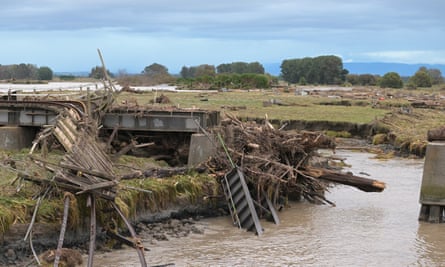At least five people have died and evacuations are continuing as fresh storm warnings are announced in regions of New Zealand already devastated by Cyclone Gabrielle.
Five people have now been confirmed dead in the storm, and the government said there were “grave concerns” for others, after reports from residents in the Hawke’s Bay region of seeing now-missing household members swept away by flood waters.
As the emergency response continued, fresh storms were arriving, with severe thunderstorm alerts issued on Thursday morning for the worst-hit areas.
National forecaster MetService issued a severe thunderstorm warning for Thursday afternoon for areas including the Bay of Plenty, Gisborne and the Hawke’s Bay region – three of the areas that have experienced some of the highest levels of flooding, damage and loss of life.
MetService said there were “very unstable conditions” including “heavy rain and hail”.
“Rainfall of this intensity can cause surface and/or flash flooding, especially about low-lying areas,” they said.

Fresh evacuation orders were issued on Thursday morning for residents of central Hawke’s Bay, with those around Drumpeel Road told to “leave immediately”.
Large parts of the Hawke’s Bay region were without power, and were expected to remain so for weeks, with thousands of people displaced.
As flood waters recede, they are revealing huge destruction: homes partly immersed in silt and mud, or shifted off their foundations. “It’s just unbelievable the devastation,” Eastern police district commander Supt Jeanette Park said on Thursday morning. “When you see it, it’s hard to comprehend.”
Hawke’s Bay civil defence officials said they were working through 3,000 reports of people who remained uncontactable – but said some of those people could have been reported twice. Police said on Wednesday night more than 1,400 people were “uncontactable” on a missing-person database.
On Thursday morning, Urban Search and Rescue said they were still rescuing people from their homes in Hawke’s Bay. In a radio interview, Napier-based Urban Search and Rescue specialist Ken Cooper said people had been climbing down from roofs to shelter in the upper parts of their properties.
“We’re finding people have moved to the roof voids of their properties, so we are still, at this moment, we are still rescuing people from their properties and there are a large number of people unaccounted for,” he said.
The New Zealand prime minister, Chris Hipkins, was expected to travel to Gisborne on Thursday to meet residents and first responders on the ground.

 1 year ago
84
1 year ago
84










 English (US)
English (US)